#bishop Vannes
Text
SAINT OF THE DAY (April 5)
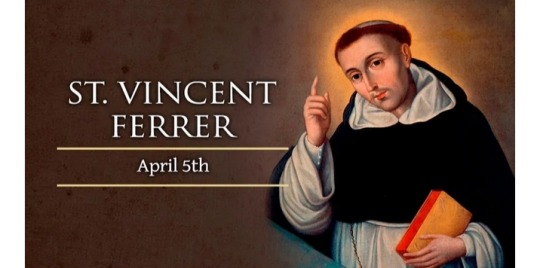
Roman Catholics celebrate the missionary efforts of St. Vincent Ferrer on April 5.
The Dominican preacher brought thousands of Europeans into the Catholic Church during a period of political and spiritual crisis in Western Europe.
Vincent Ferrer was born on 23 January 1350 in Valencia, Spain. His parents raised him to care deeply about his religious duties, without neglecting his education or concern for the poor.
One of his siblings, Boniface, later joined the Carthusian order and became its superior general.
Vincent, however, would become a Dominican and preach the Gospel throughout Europe. He joined at the age of 18 in 1374.
As a member of the Dominican Order of Preachers, Vincent committed much of the Bible to memory while also studying the Church Fathers and philosophy.
By age 28, he was renowned for his preaching and also known to have a gift of prophecy.
Five years later, a representative of Pope Clement VII chose Vincent to accompany him to France, where he preached extensively.
While Vincent sought to live out his order's commitment to the preaching of the Gospel, he could not escape becoming involved in the political intrigues of the day.
Two rival claimants to the papacy emerged during the late 1300s, one in Rome and another in the French city of Avignon.
Each claimed the allegiance of roughly half of Western Europe.
Caught between the rival claimants, Vincent attempted to persuade the Avignon Pope Benedict XIII to negotiate an end to the schism.
Benedict, who was regarded as Pope in both Spain and France, sought to honor Vincent by consecrating him as a bishop.
But the Dominican friar had no interest in advancing within the Church. He regarded many bishops of his time as negligent leaders distracted by luxury.
“I blush and tremble,” he wrote in a letter, “when I consider the terrible judgment impending on ecclesiastical superiors who live at their ease in rich palaces, while so many souls redeemed by the blood of Christ are perishing.
I pray without ceasing, to the Lord of the harvest, that he send good workmen into his harvest.”
Vincent not only prayed but acted, committing himself to missionary work and resolving to preach in every town between Avignon and his hometown in Spain.
In a commanding style, he denounced greed, blasphemy, sexual immorality, and popular disregard for the truths of faith.
His sermons often drew crowds of thousands and prompted dramatic conversions.
Popular acclaim, however, did not distract him from a life of asceticism and poverty.
He abstained completely from meat, slept on a straw mat, consumed only bread and water on Wednesdays and Fridays, and accepted no donations for himself beyond what he needed to survive.
He traveled with five other Dominican friars at all times, and the men would spend hours hearing confessions.
For two decades, Vincent and his group of friars undertook preaching missions in Spain, Italy, and France.
When he traveled outside these regions, into Germany and other parts of the Mediterranean, those who did not know the languages in which he preached would testify that they had understood every word he said, in the same manner as the apostles experienced at Pentecost.
Although he did not heal the temporary divisions within the Church, Vincent succeeded in strengthening large numbers of Europeans in their Catholic faith.
He wrote little, although some of his works have survived, and exist in modern English translations.
Vincent Ferrer died on 5 April 1419 at the age of 62 in Vannes, Brittany.
He was canonized by Pope Callixtus III on 3 June 1455.
He has recently become the namesake of a traditional Catholic community approved by the Holy See, the Fraternity of Saint Vincent Ferrer.
He is considered the patron saint of builders due to his effectiveness in building up the Church.
3 notes
·
View notes
Text
The Lioness of Brittany
This lady from Brittany lived from 1300-1359 and her real name was Jeanne-Louise de Belleville de Clisson Dame de Montaigu. She was a noblewoman from Brittany who, as heir to her family, took over the estates and the salt trade, and later a Pirate.
She married for the first time at the age of 12, the 19-year-old Geoffrey de Châteaubriant VIII, who died in 1326, and had her first two children with him at 14 and 16. After his death, in 1328, Jeanne married Guy de Penthièvre of the House of Penthièvre, widower of Joan of Avaugour and son of the Duke of Brittany, for the protection of her children. The union was short-lived, as relatives of the ducal family, particularly from the de Blois faction, complained to the bishops of Vannes and Rennes to protect their inheritance, and an investigation was held on 10 February 1330, leading to the annulment of the marriage by Pope John XXII. Then, in the same year 1330, Olivier IV de Clisson married a very wealthy Breton. They had five children together: Maurice, Guillaume, Olivier, Isabeau († 1343) and Jeanne. In 1342, Olivier, joined the Duke of Brittany Charles de Blois in the Breton War of Succession defending Brittany against the English claimants and the forces of English sympathizer John de Montfort.
During the ensuing campaign, Olivier came under suspicion and criticism from Charles de Blois for failing to hold Vannes against the English forces so Clisson defected to the English side. January 1343, the Truce of Malestroit was signed between England and France and under the perceived safe condition of this truce Olivier and fifteen other Breton lords were invited to a tournament on French soil. He was arrested and beheaded for treason against the king. His head was sent to Nantes, where it was presented on a spit on the battlements of Bouffray Castle near Nantes. His widow, Jeanne, swore revenge on the king and Charles de Blois, who had happily supported the death sentence.

A painting of Jeanne in a mock 15th century style, part of a composition by Elsa Millet. (x)
Her revenge consisted of selling her possessions and buying a ship. Dismayed by the death of her liege lord, she quickly found a crew of 400 men and together they hunted down French merchant ships. After several successful battles, including two attacks on two castles, her ship was badly damaged and she had to flee. She found protection and support in England and from King Edward. He and Breton sympathisers gave her money and she was able to buy several war cogs, which she had painted black and fitted with red sails, the flagship was named My Revenge. Because of this appearance, the fleet received the name Black Fleet. The ships of this Black Fleet are said to have first attacked ships in the Bay of Biscay, but then advanced into the English Channel to hunt down French merchant ships, killing entire crews and leaving only a few witnesses to carry the news to the French king. This earned Jeanne the nickname "The Lioness of Brittany" or in French “La Tigresse bretonne” (The breton tigress).
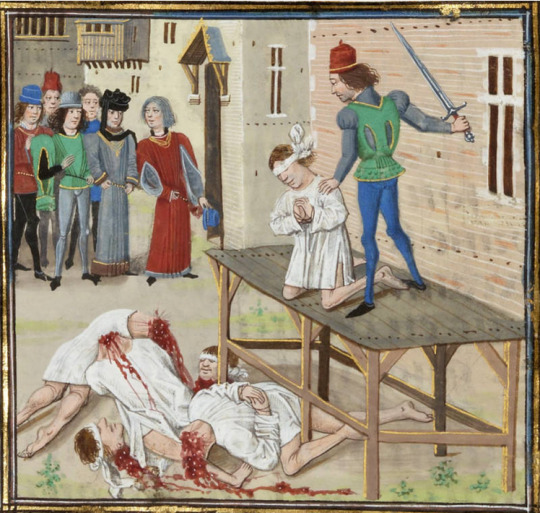
Execution of Olivier IV de Clisson. Painting attributed to Loyset Liédet, Flemish illuminator (v.1420-v.1483) in the Chronicles of Lord Jehan Froissart. (x)
She is sometimes referred to in literature as a privateer of the English, which would imply that she was subject to certain protections and obligations, but there was no known letter of marque.
In 1346, during the Crécy campaign in northern France, Jeanne used her ships to supply the English forces.
In the process, the French eventually succeeded in attacking her fleet and sinking her flagship. Jeanne and her two sons drifted at sea for five days; her son Guillaume died from the effects of the cold. Jeanne and Olivier were eventually rescued and taken to Morlaix. But this did not stop their revenge, on the contrary Jeanne continued her piracy in the Channel for another 13 years.
She probably ended her revenge in 1356, but by 1850 she had married the English nobleman, Walter Bentley, lieutenant to King Edward III until 1353 and captain of the English troops who continued to fight Charles de Blois. For his services and inheritance, both had received lands and castles in Brittany, which they were to relinquish in 1353 in order to finally achieve peace Charles de Blois. Bentley refused and was imprisoned in the Tower of London. Jeanne, tired of fighting, gave up and handed over the lands they had wanted. He was then released and in January 1357, the barony of La Roche-Moisan was granted to them. Toward the end of her life, she returned to France and has lived in Hennebont castle until the end of her life in 1359.
#naval history#female pirate#jeanne de belleville#the lioness of brittany#14th century#medieval seafaring
81 notes
·
View notes
Text
Le Baud gives a detailed account of the response of the Breton aristocracy ("les Barons’) to this state of affairs. They managed to communicate with the captive Duchess through the Seneschal o f Rennes, who relayed the Duchess’s mandate that the barons should, "se tirassent à son fils Artur, et qu’ils luy fissent fidelité et hommage, et luy servissent et obéissent, en faisant pour luy ainsi qu’ils avoient fait pour elle". Arthur being of such a young age, he would not have received the barons’ homage before, and presumably Constance was seeking to secure Arthur’s succession in the event that she was never freed. Consequently, Le Baud continues, the barons assembled in the presence of Arthur at Saint-Malo de Beignon (canton Guer, arrondissement Ploërmel, département Morbihan).
If Le Baud is to be relied upon about the location, it is significant in interpreting the evidence for this assembly. Saint-Malo de Beignon was a rural estate and a summer residence o f the bishops o f Saint-Malo in the hinterland o f the diocese, towards the centre of eastern Brittany. The location may have been chosen for the security of the young Arthur, who had to be protected from being physically taken into custody by Richard’s men. It would have offered greater security to all the participants in the assembly than a location nearer to the coast or the eastern frontier. The latter was completely controlled by the Angevin ruler as Duke o f Normandy, Count of Anjou, and Count of Poitou. It was also neutral territory in the sense that it was not ducal territory, and it was physically quite central and proximate to the estates of most of the barons involved.
Le Baud implies that the barons assembled at Saint-Malo de Beignon to render homage, at the request of Duchess Constance, because Arthur was already there. The implication that Arthur was staying at a residence of the Bishop o f Saint-Malo suggests that the bishop played an important role in this affair. Perhaps more generally the impetus came from the bishops, because the Bishop o f Vannes, Guethenoc, also took an active role, later taking responsibility for the delivery of Arthur to the custody of Philip II Augustus o f France (1180-1223). Bishops would also have had the administrative resources, for instance, to draft and send out letters of summons.
Judith Everard, Aristocratic Assemblies in Brittany, 1066 -1203
2 notes
·
View notes
Photo

Here are my Three Musketeers bookmarks.
Left to right:
1. Athos, “The Musketeers” (BBC TV series) version played by Tom Burke. A gift for @ja87.
2. Athos, the version from my imagination based on the books of Dumas. A present for a person who doesn’t have an account here.
3. Aramis as the cunning bishop of Vannes, my own version based on the books. A gift for myself. :)
#three musketeers#athos#atos#aramis#count de la fere#comte de la fere#Les Trois Mousquetaires#vingt ans apres#Le Vicomte de Bragelonne#alexandre dumas#rene d'herblay#tom burke#the musketeers#bbc
29 notes
·
View notes
Text

We set up our Grand Wedding and Changed the Intent to that of Matchmaking during the festivities for Duke Konan's unmarried Half-Brother Jafrez. The entire Grand Wedding operations cost 205 gold to orchestrate.




The Grand Wedding celebrations kickstart with Princess Gunhild traveling all the way from Sjaelland, Denmark to Gwened, Vannes, Brittany.

Just before the Wedding Ceremony takes place, Gunhild's brother Prince Svend complains about the wedding arrangements non-stop. There were a total of 3 events in which he participated as an antagonist in every single one of them, out of which I'm choosing to only show one. Anywho, Duke Konan manages to placate him and stop the constant complaints from Svend.




A sweet little thing happened just before the couple said their vows, Duke Konan and Princess Gunhild have fallen in love at first sight and became Soulmates. In front of officiant Bishop Guobrian, they said their vows of "I do".


Then begins the Wedding Banquet segment of the celebrations. Duke Konan's guest Gwilherm manages to trip and caught his clothes on fire from the fire dancers' torch, to which Duke Konan responds in his hysterically Craven manner: "EVERYONE FOR THEMSELVES!"

In the middle of festivities, Duke Konan promotes a Knight who was recruited by his Marshal Count Morvan, named Courantgern Guennec who is Stubborn, Brave, Lustful and Hale, not to mention a Skilled Tactician.


Just before the Bedding Ceremony, Princess Gunhild gifts Duke Konan a Lock of her Hair tied with a silk ribbon as a token of her affection.

The Knight Indomitable Accolade has found its worthy successor in the form of Courantgern Guennec who is Brave which is a requirement for the Valiant attribute.
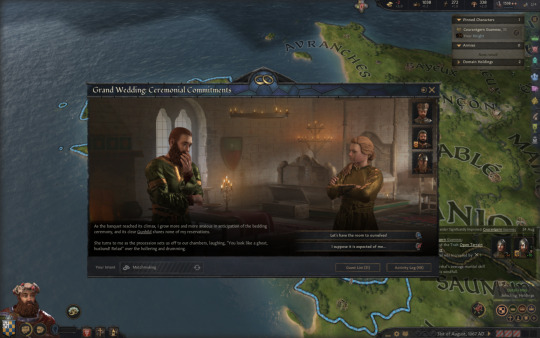



Finally, the couple get jiggy with it during the Bedding Ceremony and lay with each other. After that, the Grand Wedding celebrations come to an end. Our Matchmaking Intent for our Half-Brother failed as there were no eligible single women available for him. However, we gained a whole host of good modifiers, prestige and opinion boosts.
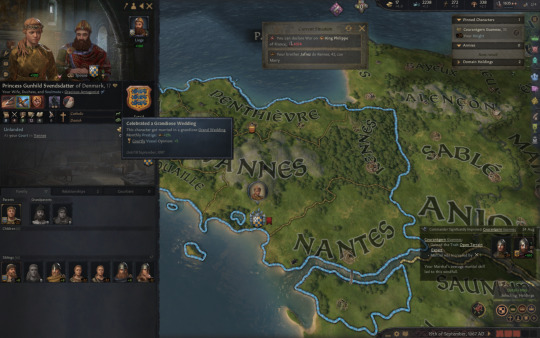
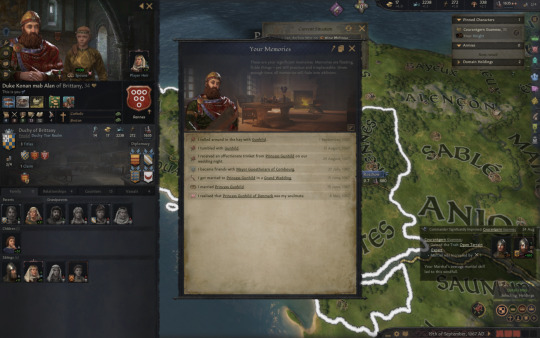
After the Grand Wedding, we note that Princess Gunhild has changed into her Duchess clothes and Duke Konan gained 2 memories of having laid with her.
1 note
·
View note
Photo

New Names Old Gods: A look at Seeking Rituals in Pentecostal and Gullah Religions
The Case for Structural Ritual Transcendence
Religious rituals and cultural traditions are often not isolated practices. In that I mean, most religious traditions can find root in various cultural and societal practices. In some cases, entire rituals can be survivals from other religions, or blended expressions of culture, tradition, faith, etc. One example of these, are African-American religious traditions. These religious traditions are often described as blended faiths, exhibiting intersectionality between tradition, culture, and religion. Many religious practices in the African-American community are a bricolage of various cultural and religious intersections; a kind of hybrid. Evidence of such can be found in Christian, Islamic, and even Judaist traditions.
In terms of Christianity, most scholars have often pointed to the antebellum south and African slaves as significant evidence of some hybrid practices we see today. This paper does, however, suggest that the antebellum south and slavery gave way for the development of new religious traditions and practices via a blending of Africanisms from slave culture and theological premises taught them from various missionaries visiting slave plantations. This in many ways created new blended religious traditions, of which portions can be seen today. While this paper focuses on the blended Christian practices that extend from this time, there is evidence of other traditions that can in some way find lineage among African-American Slaves. However, we are often limited on an anthropological level to substantiate clearly, and or determine precisely, such progressions and development of that religious history.
Some often struggle to trace a progression from invisible slave institutions like Hush Arbors to visible institutions like Praise Houses, then to the modern African church. However, through analysis of rituals, in particular, the seeking ritual, we can show a historic connection between African-American Slave traditions and modern African-American Christian tradition (IE. The Pentecostal African Church). While the African-American Pentecostal Church and Slave Religious Traditions, such of those of the Gullah People, may differ theologically, there remain rituals among the two that prove a connected history and a structural ritual transcendence. By structural ritual transcendence, I coin the phrase to suggest that there maintains a structural and functional continuity in the performance of like rituals that are, nevertheless, interpreted in significantly different ways. Even if the religious traditions being examined are completely different. To further that point, I present information that suggests that rituals entirely transcend theological premise and can maintain such function.
We will see this among the Gullah Tradition that extended from the seas-islands of the Carolinas and The African-American Pentecostal Church, which at times may be referred to as the African Church. While the African Church and the Gullah Tradition share a common ancestral history, being that most congregants are decedents of former slaves, there are clear theological differences. Despite having no direct lineage, the presence of the seeking ritual in both traditions speaks to a connected history. The seeking ritual in both religious traditions is structurally and functionally similar; and for both traditions, seeking is a rite of passage into a church or community. The ritual involves communication with the divine, validation by a spiritual leader, and testimonial-given by the individual in the ritual. The seeker is separated from the community sent on this seeking ritual then returns to the community for approval.
While this paper does not focus entirely on theological differences, it aims to emphasize the connected history of both traditions as a way to show the origin of the seeking ritual itself. While the ritual survived, the same theological basis of the ritual did not. Thus proving, that rituals can maintain structural continuity regardless of theological convictions. This paper will review and analyze a ritual from both slave traditions and the modern Pentecostal African church. Through reviewing this ritual, we can in some way substantiate two claims. First, that there is a connection between slave traditions and the African church. Secondly, that rituals can transcend theology and maintain similarities both structurally and functionally. Throughout the paper, we will further these points utilizing Arnold Vann Gennep and Victor Turner who provide a theoretical lens in the discussion of rites of passage and more broadly the pre-liminal, liminal, and post-liminal stages of such rituals.
Gullah and Pentecostalism
This paper examines such ritual and or Rite a passage into the Praise House known as “seeking”. We also examine this ritual as presented in the African Church particularly the Pentecostal denominations. As previously articulated, this paper will show a connection between the Gullah faith and Pentecostal church through the category of rituals and through the theoretical lens of liminality, rites of passage, and functionalism. While doing this, we show the link between the Pentecostal church and Gullah Religion. In particular, utilizing the House of God Church, Church of the living. While most present a connected history between the African Church and slave traditions hinged on ancestral and cultural bounds. By showing the seeking ritual as being structured the same and functioning similarly, one can validate a further connection that previously is not entirely accepted.
The Gullah People are slave population or the descended of slaves that were brought to America from various parts of Africa mainly from Angola and Sierra Leone. The Gullah people were brought to be slaves on rice plantations in the low-country of South Carolina, North Carolina, and the parts of Georgie. These rice plantations were entirely on sea-islands which were distant from the mainland. This unique characteristic gave the Gullah slaves a limited freedom that becomes a microcosm for various institutions. One of which being the Praise House. Slaves often met for various purpose in the antebellum south. These meetings were done in secret as to not alert plantation owners of their gathering. These meetings become a silent institution known as Hush Arbors. The Hush Arbors to the Gullah morphed into a visible institution known as Praise Houses. The limited supervision from overseers on the sea-islands provide the slaves to meet together and thus form institutions with religious and social impact.
While Hush Arbors were a silent institution for social organization and organizing, some slaves were able to have more public means of gathering and even self-governing. In the Sea Islands of the Carolinas and Georgie, Praise Houses became a cornerstone of life on the plantation. In these parts, the Gullah People were slaves who lived on plantation Sea Islands separate from the mainland. While yet slaves, the Gullah People experienced less observation and even given the opportunity to worship and gather in such Praise Houses. These churches became to function as not only the center of religious life but also a social and judicial hub. Praise Houses were used to create social rules and enforce these rules when disputes arose. It is here, in the Praise Houses, you see the birth of the Gullah Religions, which blended Christianity and Africanism, often to create newfound faiths and various new traditions. Praise Houses were essential to life and thus admission into such was in a way admission into full integration into Gullah traditions. The same can be found in churches today; particularly the House of God Church-Keith Dominion.
The House of God, Church of the Living God, The Pillar and Ground of the Truth Inc. was founded in 1903 by Bishop Mary Magdalena-Lewis Tate. She is noted as being the first African-American Bishop in the world. This particular organization was founded in Nashville, TN with various dioceses (jurisdictions) in numerous parts of the country; even including Rochester, NY. This church is one of the earliest African-American Pentecostal churches and also has deep roots of origin in the south. However, to both the Gullah and the African-American Pentecostals seeking is vital to each of the religions. We will examine the theological premises in subsequent sections, however, it is important to note the structural and functional similarities of both seeking rituals.
Structural Ritual Transcendence
While both rituals differ ideologically, the functionality of the two are the same. Both rituals serve as rites of passage. In the House of God Church, like most services similar to the Gullah Tradition in Praise House, include huge levels of charisma and energetic liturgy. Sermons tend to be very spiritual and speak to the coming of Christ like many mainstream Christian denominations. The tenets of the Pentecostal church are fundamentally the same as other Christian denominations, but differs in the sense that Salvation is through the acceptance of Christ and the endowing the Holy Spirit. In order to be a part of the church or the body of Christ, you have to be full of the Holy Ghost and produce certain signs like Speaking in Tongues, Shouting, etc. For some Pentecostal churches this rite of passage, is done through prayer with various degrees and styles. Due to the charismatic nature of the Pentecostal Church, this ritual is done with extended periods of prayer, trances like conditions, communication with the divine, visions, etc. This is similar to the Gullah, in that, admission into the Praise House was not inherent through attendance, one must go through the seeking ritual. To this end we can look at the rituals in light of Arnold Vann Gennep and Victor Turner.
Arnold Van Gennep suggests rites of passage as having three main phases in its structure. Separation (Pre-liminal), Transition (Liminal), and Incorporation (Post-Liminal) respectively. For the Seeking tradition the Pre-Liminal and the Post-Liminal are socking similar. The liminal stage given its nature presents a difficulty to see overarching trends as in each ritual the experience is based heavily on individual experience. Victor Turner recapitulates the nuances of liminality in his writings. For Victor Turner, the Liminal stage is a phase where the person is “betwixt and between”. Victor writes,
“The attributes of liminality or of liminal personae (“threshold people”) are necessarily ambiguous, singe this condition and these persons elude or slip through the network of classifications that normally locate states and positions in cultural space… As such, their ambiguous and indeterminate attributes are expressed by a rich variety of symbols in the many societies that ritualize social and cultural transitions. Thus, liminality is frequently likened to death, to. being in the womb, to invisibility, to darkness, to bisexuality, to the wilderness, and to an eclipse of the sun or moon.”
The Pre-Liminal stages of seeking both derive from to be included in a community. For the Gullah, the seeking ritual was blended from early Methodist in the slave quarters (hush-arbors) asking African slaves if they would “seek” Jesus after hearing sermons. This in time blended with Africanism that created a process required for admission into the Praise Houses. In the Pre-Liminal stage of seeking to Gullah, they are sent into the wilderness and physically separated from the community and guided in part by a “spiritual parent”. This is also evident in the Pentecostal African Church. Where by a person looking to join the church would have to come to an altar and be guided by the clergyperson to begin the seeking. Coming to the altar or being sent to the wilderness show a separation and even a belief that one most go to a particular place for the ritual to work; axis mundi.
The Liminal stage of seeking is this important and in the Pentecostal church and the Gullah tradition it is heavily important. In actuality, while liminal stage is experienced difference between the Gullah and Pentecostal church is has the same function and even substantiate Victor Turners view of the liminal stage. What occurs in the liminal stage to the seeker determines admission into the community. The Post-Liminal stage in contingent on the experience and even communal validation of the liminal stage. In the Gullah Tradition, the seeker experiences various stages of interaction with the divine and ancestors. Communication with Ancestors is a vital component, as the ancestors are consider guides to the seeker. They the seeker through personal development and conviction. This can be considered similar to processes of repentance for the seeking ritual in the Pentecostal African Church. In the liminal stages, the seeker in the African church also has this communication with the divine and in this individualistic manner goes through repentance and spiritual conviction. The seeker is expected to be “godly sorry” for their sin and after this repentance one can be empowered with the Holy Spirit. Both the Gullah and African Church share this structural essence of spiritual nuance. For the Gullah people, the liminal stage is the wilderness and the for the Pentecostals the Liminal stage is being “born-again” through seeking for the Holy Spirit on the altar. Such symbols are articulate as clear liminal imagery according to Victor Turner.
The Post-Liminal Stage of Incorporation is key. In this part with see distinct similarity between the Gullah and the Pentecostal African Church. Particularly, in terms of communal validation and acceptance. During the liminal process the seeker is physically disconnected from the certain parts of their community. In the Gullah this is being sent to the Wilderness and in the African Church this is coming to the Altar. In the Post-Liminal when the seeking is incorporated into the community we see the requirement of communal validation. In the Gullah, the seeker has to stand before the elders of the Praise House and describe what occurred and what message was told them from the ancestors or God. This has to be approved by the Elders as a genuine experience and one may even be asked question as to ascertain such validity. This is exactly duplicated in the Pentecostal African Church. After the clergy has observed certain “signs” the seeker has gone through the proper processes. The seeker is picked up from the Altar placed in front of the church to “testify” as to what occurred. The elders of the church listen and to validate that the seeker has received the Holy Spirit. In both instances of the Gullah and Pentecostal Church, going through seeking ritual is not enough. The Communal Validation is unique structural component particularly in a church environment. For a church to use terminology of seeking, to use the ritual functionality as a rite of passage, and to include structural component unique to the Gullah Tradition, overwhelmingly validates a claim that both tradition extend from a connected history.
Furthermore, the in each ritual the theological premise is fundamentally different. The Gullah place huge importance on communication with ancestors and placement of ritual in the wilderness. While theologically, Pentecostals place huge importance on personal repentance and receiving of the Holy Spirit. Even the role of Ritual is slightly different on a theological term. While both use the seeking ritual as rite of passage and forms of admission. To not go through the ritual to the Gullahs means no admission into the Praise House and thus the community. However, to not go through seeking in the Pentecostal Church would mean one has not obtained the Holy Spirit and thus will not enter Heaven. It is a matter of salvation to the Pentecostal that is not entirely, if at all, evident in the Gullah Tradition. The evidence in this paper exhibit clear that rituals in fact can transcend theology and maintain a structural and even functional continuity.
The Seeking Practice to the Gullah
Seeking is an essential part of Gullah traditions and particularly the Praise House. The role of this ritual serves as rite of passage and functions as the tool for admission into the Praise House and ultimately the Gullah Community. It is important to note that the spiritual aspect of Seeking presents some difference of experience interns of what the ritual means to every person. However, this notation is no different than any other religion. For many religions, iconography or symbols can mean a host of things for people. Yet, if one should analyze the seeking ritual in terms of Victor Turner or Arnold Vann Gennep you can see a structural continuity both in the Gullah traditions and in the Pentecostal church.
Seeking in the slave religion of Gullah was ritual that proceeded full-emersion baptism which is another key to admission into community. Seeking symbolized the death of the old person and the birth of a new person. The origins and the nomenclature of seeking actually came from Methodist ministers who after preaching would ask slaves if there were anyone who would “seek Jesus”. However, over time this ritual began to blend with Africanism to create the Gullah Seeking tradition. The ritual was a solitary and individualistic ritual into the wilderness that was led by a spiritual leader called a “Spiritual Parent”. The ritual included prolonged prayer and meditation. During this process, the seeker would go into a trance and speak with natural objects, ancestors, and God. Often these are done via dreams and other visions. The seekers would then have to return to the community and give an account of what happened. This would have to then be reviewed by the elders of the community and be confirmed as a genuine spiritual experience. The ritual involves much ideology and activity related to ancestors and being spiritually guided. This is depended not on a ritualistic format but speaks greatly to the liminality Victor Turner speaks of.
What is very interesting is the theological premise of the ritual. While simplistic in structure you see a unique paralleled in Pentecostal in the way the ritual happens. Essentially, the ritual is about a seeker that goes on a trip into the wilderness, has a dream, comes back, tells that dream, and if the elders agree the seeker, is accepted. However, the theological culture aspects of this ritual provide resemblance of seeking in the Pentecostal churches. For the Gullah People, being blended provides the language of Christianity but the belief of survivals from African religions; or with no real basis at all. By that I mean, they maintained the language of Christianity but associated them with things other than typical Christian thought. Jesus could have been God but also If asked who Jesus was it could have been a slave master or plantation worker.
The Seeking Practice to the House of God
There are numerous comparisons among the Pentecostal experience of seeking and the Gullah Faith traditions. It is important to note that this ritual can be called various things in the Pentecostal church i.e. tarrying, seeking for the Holy Ghost, Laboring at the Altar, or simply praying. However, I utilize The House of God Church — Keith Dominion as our case study for various reasons. First, there is no direct link between the Gullah Tradition and this particular church. This is important because it eliminates any rebuttal which might suggest that the reason the seeking ritual has survived is due to a direct link. The House of God Church, Church of the Living, was founded in 1903 by an African-American woman in Greenville, Alabama and Nashville, Tennessee. The Gullah Tradition, while certainly significant to African-American, we see no real influence wide spread. We see connectivity to Africanism present in slave populations and persons of African descent. Therefore, while I am not asserting that the Pentecostal Church derives from the Gullah Faith, I am suggesting that both the Gullah faith and the African-American Pentecostal Church extend from a complex process of slave trying to grapple with Christianity and some survivals from African culture.
Secondly, I use The House of God Church Inc. — Keith Dominion because it is a mainstream denomination that uses similar nomenclature and ritualistic structure of the Gullah People. Terms like seeking, seekers, vison, are used in explaining the ritual theologically. And the ritual’s structure mirrors- in many ways- the Gullah practice. While, our paper does not provide scholarship toward just what both the Pentecostal and Gullah church extend from, our paper does capitulate an argument that ritual can transcend theology and maintain its structure.
The Seeking Tradition in the House of God Church is structurally similar because it focus on a few aspects similar to the Gullah Tradition. The “preacher” serving a dual role as a “spiritual parent” and “Elder” like in the Gullah Tradition. The individualistic characteristic of the process. The experience of the seekers in both tradition including a communication with the divine, and visionary experiences. Also, the affirmation aspect of the seeking process which provides admission into the church or community is duplicated in both traditions. The setting of the seeking process is important to note. In most services, after the preaching, the Elder or Clergyperson of the church would do what is called an “Altar Call”. Two types of things can happen during this time. One, a person can simply go up for individual prayer or for corporate prayer. However, if one desires to be filled with the Holy Spirit the clergyperson would begin the seeking ritual. This is important because one must note that the seeking practice in the Pentecostal Church is not just a general prayer. It is initiated under special conditions like in the Gullah Tradition. Also, like in the Gullah Tradition, the Preacher at the beginning of the seeking tradition become a spiritual parent. While observing this ritual at a local parish of the House of God Church Inc., The preacher acting a coach and guide began to instruct the seeker to close their eyes, focus on Jesus, picture him on the cross. They are often instructed to get in a praying position and begin to “seek” the lord and cry out to him, confessing their sins. When asked many seekers experience seeing Jesus and having dialogue with him. In this trance state, you see many parallels to the Gullah People which experience seeing ancestors, angels, and various persons. In fact, these vision have a principle of guiding the seekers; the same is evident in this Pentecostal Tradition. During, this time the preacher is also singing and clapping. Other who have already gone through the process and are members of the church create a circle around the seeker and begin to clap and sing spiritual songs, hymns, etc. The theological premise to this is that the strong of the church should support this seeker and also stand as a physical shield against spirits (the devil) that will come to distract the seeker while he/she is seeking the lord. The preacher watching attentively at the movement of the seeker and the sincerity of the seeker would then instruct the seeker to begin “calling” on the name of Jesus. During this process of seeking, it is called tarrying (calling on the name of Jesus), this is done by saying the names Jesus repeatedly. This is said to keep your mind focused on Jesus.
After the seeker has gone through the process of seeking, and certain actions has occurred like dancing, or speaking in tongues, or personal affirmation. The seeker is then picked up off the altar or if stand is escorted to the front bench of the church or a chair by the preacher. At this point, the preacher ask the seeker certain questions as to ascertain if the Seeker had been truly filled with the Holy Spirit. They would ask things like “How do you feel?”; “What happened to you at the altar?”; “Do you believe God touched you tonight?”. This is very similar to the structure of the Gullah Tradition, where testimony is given before the Praise House and questions asked to confirm if the seeker had in fact been through the process successfully. The same happens in the Pentecostal church, while the seeker is talking, the preacher listens and makes suggestions as to if the seeker should return to the altar the next time or if this is sufficient. If the seeker has proven to be filled with the Gift of the Holy Spirit the church rejoices, like in the Gullah Tradition, and extends the “Right Hand of Fellowship”. In the Pentecostal church, one often cannot hold any church position unless that are filled if the Holy Spirit and thus they would have had to go through some sort of seeking process.
A Connected History
For much of the history of African people America, the “African Church” has played a pivotal role in their history. Insomuch, that the “African Church” worked as epicenters of religious, social, and communal activity. In the height of the civil rights movement and even in Post-Antebellum America the African Church was often used as a location for organizing meetings and gathering support for various social justice activities. In many instances, Pastors and African-American preachers used the pulpit as an unfiltered platform to oppose racism and oppressive policies in the country. The institutionalized African church, also provided an opportunity where by which African-Americans could theorize and form new theological belief that centered around a God who would one day liberate them from their oppression. Organizations like the National Baptist Association, The African Methodist Episcopal Church, The African Methodist Episcopal Zion Church, The House of God-Church of the Living God, are examples of these institutions.
While, the Affrican Church various ways extends from old slave institutions like Hush Arbors and Praise House, it is important to note, that in no way am I suggesting a social morality exclusive to the Christian faith. However, it is heavily documented the theological persuasion of many slave being rooted in Christianity. Thus, the Hush Arbors and Praise houses of the Sea Islands in the Carolinas are examples of institutions that held greater significance in the community. While these institutions served as religious bodies they also functioned as hubs into the greater scheme of community. Thus admission into these institutions served as admission into the wider community. Such can be exhibited in the African-American Church. Rituals like “seeking” serve a dual function of being both a religious and societal rite of passage. While there is no clear line to show historical progression anthropologically through examining the rituals of each religion we are able to show a historical connection. The Structural Ritual Transcendence of seeking further validates the second argument of this paper; that of connection between two distinct religious traditions.
141 notes
·
View notes
Note
Hello @mordioux,
I would simply like to say that I love your blog about the Three Musketeers! Thank you for all your delicious posts! You have a great sense of humour. I've always been fascinated by some Dumas' novels! I love "The Vicomte de Bragelonne" the most of The D'Artagnan Romances set. The book is the most interesting and complex but the main reason for that is Aramis. He is so mesmerizing as the sneaky bishop of Vannes! Truly a mess of contradicitions. I'm aware that he is the Musketeer who you like the least. ;) Athos was great in the first novel but he became so irritatingly perfect in the sequels. In "The Three Musketeers" I perceived D'Artagnan as an annoying little brat. Fortunately, he was more mature and really intelligent in the sequels. I admire word duels between Aramis & D'Artagnan in "Twenty years after" and "The Vicomte de Bragelonne". :) And Porthos was... Porthos. ;) A nice and extremely loyal guy, nothing of sneakiness. ;) I'm also amazed that you know so many languages: English, French, Japanese, Greek. These are only my suppositions based on your blog. My language skills are not as impressive as yours but I admit that reading Dumas' books in French is wonderful.
Thank you again and best wishes! Keep writing! :)
Hey there, fellow musketeer fan! :) To ne honest, this blog is mostly inactive after so many years (!) and I mostly use this account to browse stuff from time to time. Seldom do I receive any asks anymore. But! I'm really glad you enjoyed my silly gifs 😊 Perhaps I'll revive the entire thing and I'll make more, who knows 😅 Aramis is indeed my least favorite, but he's the one that I made a mini comic about already, so his character has had his fair share of appreciation on my part 😛 I also agree with your views on the books and the characters. Oh, and thank you for your kind words 😊 However, Greek is my native language and my Japanese is very, very poor, so I guess my language skills are not that exceptional after all 😅😅
Thanks for dropping by, feel free to ask and discuss anything related to the saga. I may not visit tumblr as often as I used to, but I'll find me a few minutes to reply 💜
20 notes
·
View notes
Text
SAINT OF THE DAY (April 5)

Roman Catholics celebrate the missionary efforts of St. Vincent Ferrer on April 5.
The Dominican preacher brought thousands of Europeans into the Catholic Church during a period of political and spiritual crisis in Western Europe.
Vincent Ferrer was born on 23 January 1350 in Valencia, Spain. His parents raised him to care deeply about his religious duties, without neglecting his education or concern for the poor.
One of his siblings, Boniface, later joined the Carthusian order and became its superior general.
Vincent, however, would become a Dominican and preach the Gospel throughout Europe. He joined at age 18 in 1374.
As a member of the Dominican Order of Preachers, Vincent committed much of the Bible to memory while also studying the Church Fathers and philosophy.
By age 28, he was renowned for his preaching and also known to have a gift of prophecy.
Five years later, a representative of Pope Clement VII chose Vincent to accompany him to France, where he preached extensively.
While Vincent sought to live out his order's commitment to the preaching of the Gospel, he could not escape becoming involved in the political intrigues of the day.
Two rival claimants to the papacy emerged during the late 1300s, one in Rome and another in the French city of Avignon. Each claimed the allegiance of roughly half of Western Europe.
Caught between the rival claimants, Vincent attempted to persuade the Avignon Pope Benedict XIII to negotiate an end to the schism.
Benedict, who was regarded as Pope in both Spain and France, sought to honor Vincent by consecrating him as a bishop.
But the Dominican friar had no interest in advancing within the Church and regarded many bishops of his time as negligent leaders distracted by luxury.
“I blush and tremble,” he wrote in a letter, “when I consider the terrible judgment impending on ecclesiastical superiors who live at their ease in rich palaces, while so many souls redeemed by the blood of Christ are perishing. I pray without ceasing, to the Lord of the harvest, that he send good workmen into his harvest.”
Vincent not only prayed, but acted, committing himself to missionary work and resolving to preach in every town between Avignon and his hometown in Spain.
In a commanding style, he denounced greed, blasphemy, sexual immorality, and popular disregard for the truths of faith.
His sermons often drew crowds of thousands and prompted dramatic conversions.
Popular acclaim, however, did not distract him from a life of asceticism and poverty.
He abstained completely from meat, slept on a straw mat, consumed only bread and water on Wednesdays and Fridays, and accepted no donations for himself beyond what he needed to survive.
He traveled with five other Dominican friars at all times, and the men would spend hours hearing confessions.
For two decades, Vincent and his group of friars undertook preaching missions in Spain, Italy and France.
When he traveled outside these regions, into Germany and other parts of the Mediterranean, those who did not know the languages in which he preached would testify that they had understood every word he said, in the same manner as the apostles experienced at Pentecost.
Although he did not heal the temporary divisions within the Church, Vincent succeeded in strengthening large numbers of Europeans in their Catholic faith.
He wrote little, although some of his works have survived, and exist in modern English translations.
St. Vincent Ferrer died on 5 April 1419 at age 62, in the city of Vannes in the French region of Brittany.
He was canonized by Pope Callixtus III on 3 June 1455.
He has more recently become the namesake of a traditional Catholic community approved by the Holy See, the Fraternity of Saint Vincent Ferrer.
2 notes
·
View notes
Photo
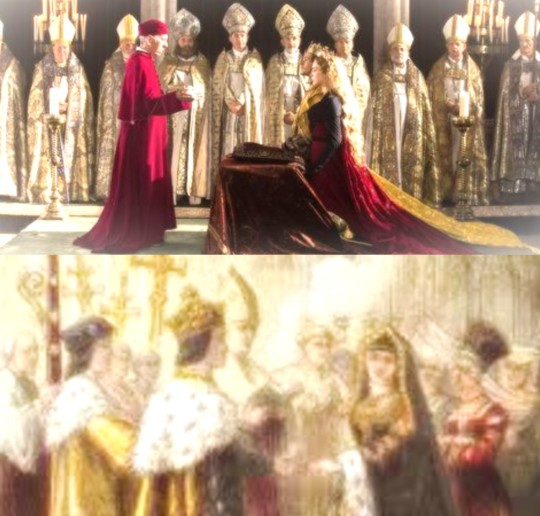
18 JANUARY 1486: The Union of Elizabeth of York and Henry VII of England.
There is a not a lot of information regarding the wedding ceremony. Henry VII had swore he would marry Elizabeth when he had been in exile in Brittany, at Vannes Cathedral, three years prior. A lot had happened since then though. The papal dispensation that their mothers had secretly plotted to get had to be reissued.
The papal dispensation covered the Earl of Richmond and the natural daughter of Elizabeth of York (meaning the Lady Elizabeth, not the legitimate daughter and heiress of Edward IV). It was vital that the couple married under the good eyes of the church. The fifteenth century had descended into chaos when two branches of the Plantagenet House had annihilated each other, their descendants had married off to other noble houses and as a result (after Bosworth), Henry claimed the crown.
But he was not blind. Connquering and ruling were two different things. He needed stability or at the very least, give the illusion of it to the people to put down civil unrest.
Therefore, he needed to marry Elizabeth who was the eldest living descendant of the first Yorkist King. The papal dispensation took time, and meanwhile Henry had to establish himself as the realm's ruler. He established his claim to the throne through his "right of conquest" and his mother, Margaret Beaufort whose family descended from John of Gaunt via his third marriage to his mistress, Katherine Swynford.
Nevertheless, his claim to the throne was still seen as weak, which was why parliament asked him on December 1485, two months after he had been crowned, to keep his promise to marry the Princess Elizabeth, and strengthen the claim of his descendants and *"restore some stability to the English royal line."
The pope had finally granted the dispensation at the beginning of the year, and it was confirmed in England by the papal legate, the Bishop of Imola on 16 January, two days later the coupe were married.The wedding ceremony was officiated by the archbishop of Canterbury, Thomas Bourchier. Given the statement that Henry wanted to make, as it was mentioned earlier, about their union; the Abbey would have been filled with Tudor imagery that Henry had created that gave a new interpretation of the dynastic conflict that is now known as the wars of the roses. By intertwining the white rose of York (Edward IV's favorite symbol besides the sun in splendor) with the red rose, Henry VII's union with Elizabeth meant to give a powerful message of peace. Illusory as it was, its impression lasted and their descendants continued to use this device and celebrate the union of their ancestors, Henry and Elizabeth. The building would have been decorated by royal colors such as "purple and gold, silk, ermine and delicate cloths of tissue." And the bride, adds Licence, "would have been splendidly dressed and adorned with jewels, lace, brocade and ribbons."
She would not have worn white, given that white was not a color worn for wedding dresses.(The first royal bride who did was in fact her daughter-in-law, Katherine of Aragon, when she married Prince Arthur). Elizabeth would have likely worn purple as it symbolized royalty, or taken one of her many new gowns.
After the archbishop placed the golden ring on Elizabeth, the couple said their vows. Following royal custom, Elizabeth promised to take Henry as her husband "for fairer, for fouler, for better, for worse, for richer, for poorer, in sickness and in health, to be blithe and amiable, and obliging in bed and at board" till death do them part.Besides the expenses, that no doubt would have been great, Elizabeth would have seen the new rose, the Tudor rose in every corner as well as her husband's other badges. By intertwining the white rose of York (Edward IV's favorite symbol besides the sun in splendor) with the red rose, Henry VII's union with Elizabeth meant to give a powerful message of peace. Illusory as it was, its impression lasted and their descendants continued to use this device and celebrate the union of their ancestors, Henry and Elizabeth.In recent fiction the two have been portrayed as an unhappy couple, pushed into the marriage by their shrewish mothers, but this is an interpretation based on secondary sources that have come many years (more than a century in fact) after the even took place. Francis Bacon writes very colorfully of Henry, and negatively of his mother but Francis was writing a century after the events took place and the two George Bucks themselves wrote even later. It is very easy to believe these sources, but if we want to look at the couple, we just have to look at their actions, at what they faced and what moral attitudes people had in this period.
A young woman such as Elizabeth would not have missed the opportunity to regain her status as Princess, and much less to be Queen. After being bastardized, and forced into hiding at Westminster, then in the midst of intrigue in the Ricardian court (with rumors -whether they are true or not, we will never know- that her uncle wanted to marry her shortly after his wife's passing and he later recanted after people protested at such an idea that he began to look elsewhere for a bride, and a spouse for Elizabeth); she would have no doubt welcome this new change in status. Elizabeth was a Princess-born, she had at one point been betrothed to the heir to the French Crown. She could not accept no better offer than to be a Queen, as it would also bolster her family's position as well and it did. Henry VII rewarded the Woodvilles. Richard Woodville as the third Earl of Rivers lived comfortably, Elizabeth Woodville kept some of her dower properties and when she was present, she always took precedence. Even Margaret Beaufort had to walk behind her as the older woman was Queen Dowager whereas Margaret was just a Countess -a Countess in her own right but a Countess nonetheless. Sir Edward Woodville, Elizabeth of York's uncle who took after his late eldest brother, was a highly pious and adventurous individual who proved his loyalty many times and was favored. The Catholic Kings themselves spoke very finely of him after his death. The set of ordinances that Edward IV had made for princes and that Anthony Woodville had supervise for Elizabeth's brother, Prince Edward, was kept and used for Arthur's upbringing. And Elizabeth herself was not left behind.
**"Like her parents, Elizabeth of York was a patron of William Caxton and his successor at the Westminster printing press, Wynkyn de Worde."
Furthermore, as Queen, she ruled over her own court and her own properties -some of which had previously belonged to her aunt Isabel, the Duchess of Clarence.As for Henry, this was also a personal triumph. Born to Margaret when she was thirteen (a birth that scarred her immensely. She would have no more children). Given as a ward to William Herbert who was given his uncle Jasper's earldom of Pembroke, and raised to be the perfect Yorkist to neutralize the threat he might pose in the future, he was then sent into exile after the Lancastrian Readetion failed and every member of the royal house was eliminated. Henry lived in a period of uncertainty, danger, and now it was all over. He was King. And he could also boast of having one important advantage. Many royal couples did not have the luxury of getting to know one another. They were married to this person or that, and whether or not they liked each other, they were expected to fulfill their duties. Henry fortunately did no have this problem. In the five month period that they waited for the dispensation to come, the two got to know each other. So when they walked down the aisle, they were not complete strangers.After the ceremonies ended, came the consummation. Elizabeth proved herself an exemplary Queen, living by the virtues of the day and this, as well as her fertility, made her well-remembered and loved. She would not be crowned until the following year, after “she proved herself” by giving Henry a male heir that autumn, less than nine months after their marriage. Given the speed in which they conceived, it is possible that the marriage could have been consummated before (since being betrothed was as good as being married. And the pope had given his approval, they knew it was only a matter of time before the bull came). But there is also the possibility that Arthur could have been premature.
Henry and Elizabeth’s marriage would remain strong, with the two relying on one another for mutual support when tragedy struck.
*From Dan Jones' Hollow Crown: The Wars of the Roses and the Rise of the Tudors.
**Elizabeth of York: A Tudor Queen and her World by Alison Weir.
I also recommend the following biographies: Elizabeth of York by Amy Licence and Blood Sisters by Sarah Gristwood.
7 notes
·
View notes
Text
Saint of the Day - 1 March - Saint Albinus of Angers (469-549) Bishop
Saint of the Day – 1 March – Saint Albinus of Angers (469-549) Bishop
Saint of the Day – 1 March – Saint Albinus of Angers (469-549) Bishop, Confessor, Monk, Abbot, miracle-worker. Born in 469 at Vannes, Brittany, France and died in 1 March 549 of natural causes. Patronage – invoked against pirate attacks. Also known as Aubin of Angers, Albino of Angers.
Albinus was born of an ancient and noble family in Brittany and from his childhood, was fervent in every…

View On WordPress
3 notes
·
View notes
Link
“The U.S. bishops say that abortion has to weigh as an especially important factor when deciding whether it is morally acceptable to vote for a candidate.
In 2019, the bishops said that “The threat of abortion remains our preeminent priority because it directly attacks life itself, because it takes place within the sanctuary of the family, and because of the number of lives destroyed.”
...The Church does not say that abortion is the only issue, but that it is a “preeminent” or foundational consideration about the moral acceptability of a candidate.
Pope Francis asked in Laudato si: “How can we genuinely teach the importance of concern for other vulnerable beings, however troublesome or inconvenient they may be, if we fail to protect a human embryo, even when its presence is uncomfortable and creates difficulties?”
In Christifidelis Laici, Pope St. John Paul II taught that “the right to health, to home, to work, to culture is false and illusory if the right to life, the most basic and fundamental right and the condition for all other personal rights, is not defended with maximum determination.”
In 2008, Bishop, now Cardinal, Kevin Farrell released a joint statement with Bishop Kevin Vann, saying that in their view, “There are no ‘truly grave moral’ or ‘proportionate’ reasons, singularly or combined that could outweigh the millions of innocent human lives that are directly killed by abortion each year.”
Also in 2008, Archbishop Charles Chaput said that Catholics who support pro-choice candidates “need a compelling proportionate reason to justify it... What is a ‘proportionate’ reason when it comes to the abortion issue? It’s the kind of reason we will be able to explain, with a clean heart, to the victims of abortion when we meet them face to face in the next life — which we most certainly will. If we’re confident that these victims will accept our motives as something more than an alibi, then we can proceed...”
In 1988, Cardinal Joseph Bernardin of Chicago was asked whether Catholics can “disqualify” candidates who support a legal right to abortion. The cardinal put it this way: “Well, certainly. That’s what the consistent ethic is all about. I feel very, very strongly about the right to life of the unborn, the weakest and most vulnerable of human beings. I don’t see how you can subscribe to the consistent ethic and then vote for someone who feels that abortion is a 'basic right' of the individual. The consequence of that position would be an absence of legal protection for the unborn.”
6 notes
·
View notes
Photo

My latest drawing.
Aramis is definitely my favourite character from all the books of Alexandre Dumas which I have read so far. ❤ I love his cunning side as the bishop of Vannes in "The Vicomte de Bragelonne". René d'Herblay is a very multifaceted person torn between the ecclesiastical life and the military one.
#aramis#rene d'herblay#bishop Vannes#eveque#eveque de Vannes#Alexandre Dumas#three musketeers#twenty years after#the vicomte de bragelonne#le vicomte de bragelonne#Les Trois Mousquetaires#vingt ans apres#mydrawing#my art#myart
55 notes
·
View notes
Photo

AUSTIN CASTS #8- THE HAUNTED CAROUSEL
MOVIE CAST:
-Channing Tatum as Harlan Bishop

-Ginnifer Goodwin as Joy Trent

-Amirah Vann as Ingrid Corey

-Ezra Miller as Elliot Chen

-Kennedy McMann as Nancy Drew

What do I change/add?
Since Ginnifer is Joy, she’s a bit more likable. Still depressed AF and blaming Nancy for everything, but more tolerable.
Miles is like, a robot human.
Ingrid and Lance Huffington are ex-spouses
Less Paula Santos
The Carousel glows at night (the explanation is paint)
Harlan’s ex con status is found out by everyone in the park
Ingrid’s sister is Lauren Corey (not MID Lauren), but her name is Lauren Corey
There is one of those drop rides at the park, that suddenly stops with Nancy all the way at the top.
Joy’s plot line is pretty much the same except there’s a few extra puzzles
same culprit, but different ending. He gets caught when Harlan is doing rounds and tackles him before he kills Nancy.
BROADWAY MUSICAL CAST:
-Dave Thomas Brown as Harlan Bishop

-Vanessa Hudgens as Joy Trent

-Brittany Mack as Ingrid Corey

-John Gallagher Jr as Elliot Chen

-Erika Henningsen as Nancy Drew

SONG LIST
ACT 1 SONGS
Captains Cove- (Nancy)
Pass for Fun- (Harlan)
Uh-Oh- (Elliot, Nancy)
The Nancy Drew Entity- (Miles, Nancy)
The Niacin Vitamin- (Ingrid)
Rock and Roll’er Coaster- (Nancy)
Procrastinator’s Dream- (Elliot)
The Nancy Drew Entity (reprise)- (Miles)
Miles- (Joy)
Spymaster Bishop- (Nancy, Harlan, Ingrid)
ACT 2 SONGS
Ex-Con- (Harlan)
Lance- (Ingrid)
Procrastinator’s dream (reprise)- (Elliot)
Somebody Just Got Done Stabbing Me There- (Harlan)
Two Bit Day- (Nancy, Elliot)
The Harmonica Clue- (Miles)
The Niacin Vitamin (reprise)- (Ingrid)
Glory- (Joy)
Oh Joy, This Is it!- (Nancy)
Right Where I Want You- (Elliot)
Joy- (Nancy, Joy, Elliot, Harlan, Ingrid)
#austincasts#CAR#it might be an insult to cast Ginnifer as Joy ).o#but it has been done#she would make Joy likeable#rizzo Vanessa is what she will look like as joy
20 notes
·
View notes
Text
A3! and its Saints: Spring Troupe
The last installment of this series ends with the Spring Troupe, along with its corresponding feast days!

March 9 - Sakuya Sakuma
St. Frances of Rome: Italian wife, mother, mystic and organizer who is known as the foundress of the Benedictine Oblates. Her last words before her death were 'The angel has finished his task – he beckons me to follow him.' Canonized by Pope Paul V in 1608, she is the patron of widows, automobile drivers and the Benedictine Oblates.
March 30 - Masami Usui
St. John Climacus (John of the Ladder): A monk from 6th-7th century at the monastery located on Mount Sinai. He is honored and revered as a saint by the Roman Catholic, Eastern Orthodox and Eastern Catholic churches.
April 9 - Tsuzuru Minagi
St. Waltrude: Patron of Mons, Beligum. Married to the Count of Hainault, she raised four children. After her husband retired to an abbey, she herself became a nun in 656. She founded her own convent (Sainte-Waudru) and the city of Mons grew around it. Her shrine is kept in the Saint Waltrude Collegiate Church in Mons. Each year, as part of the Ducasse de Mons festival, the shrine is placed on the car d'or, a gilded cart, and drawn by horses through the city streets.
April 15 - Chikage Utsuki
St. Padarn: 6th century sanctified British Christian abbot-bishop who founded his church in Ceredigion, Wales. He built a monastery in Vannes and is considered one of the seven founding saints of Brittany. Padarn's early vita is one of five insular and two Breton saints' lives that mention King Arthur independently of Geoffrey of Monmouth's Historia Regum Britanniae.
April 24 - Itaru Chigasaki
St. Mary of Clopas: She was one of the women present at the crucifixion of Jesus and bringing supplies for his funeral. She is explicitly mentioned only in the Gospel of John, where she is among the women present at Christ's crucifixion. The Gospels of Mark and Matthew each include similar passages that are nearly identical to one another. She is remembered alongside Saint Salome in the Roman Martyrology.
May 15 - Citron
St. Isidore the Laborer: Spanish confessor known for his piety toward the poor and animals. In the morning before going to work, Isidore would usually attend Mass at one of the churches in Madrid. One day, his fellow farm workers complained to their master that Isidore was always late for work in the morning. Upon investigation the master found Isidore at prayer while an angel was doing the ploughing for him. Beatified by Pope Paul V in 1619 and canonized as a saint three years later by Pope Gregory XV, Isidore is widely venerated as the patron saint of farmers, peasants, day laborers and agriculture in general, as well as brick layers.
#random stuff#catholic#catholic saints#A3!#act! addict! actors!#harugumi#spring troupe#sakuya sakuma#masami usui#tsuzuru minagi#chikage utsuki#itaru chigasaki#citron
9 notes
·
View notes